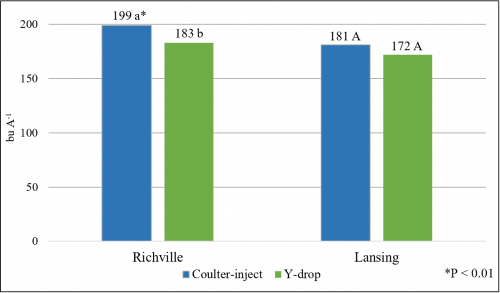Strategies for corn sidedress nitrogen placement in Michigan
Is closer nitrogen placement to the plant the key to improving corn grain yield?

Greater emphasis has been placed on applying nitrogen (N) closer to peak uptake periods in a more efficient manner thus improving corn nitrogen recovery and reducing the risk for nitrogen loss. Although few yield benefits to delayed timings of nitrogen application have been observed in this region, greater flexibility may exist with mid-season nitrogen placement strategies. New technologies have been developed to increase application efficiency by applying nitrogen more quickly and placing N closer to the plant. Instead of conventional coulter-inject sidedress nitrogen placement located 15 inches from the corn row, Y-drop application can place nitrogen adjacent to or in the vicinity of the growing plant.
The Corn Marketing Program of Michigan supported studies in Richville and Lansing, Michigan, in 2017 to evaluate multiple nitrogen placement strategies. Nitrogen rates were consistent across strategies at 170 and 145 pounds nitrogen per acre in Richville and Lansing, respectively. Three nitrogen application strategies were utilized and included:
- 50/50: 50 percent of nitrogen pre-plant incorporated, 50 percent sidedressed at V6.
- 0/100: 0 percent of nitrogen pre-plant incorporated, 100 percent sidedressed at V6.
- 2-by-2: 40 pounds nitrogen in a 2-by-2 at planting, remainder of nitrogen sidedressed at V6.
Within each strategy, sidedress nitrogen methods included traditional coulter-inject and Y-drop applications. Sidedress applications were made June 6, 2017, in Richville and June 9, 2017, in Lansing with grain yield adjusted to 15.5 percent moisture.
Averaged across nitrogen strategies, positive yield gains were not achieved using Y-drop application at either location. In Richville, Y-drop application reduced yield 16 bu A-1 (Fig. 2) and profitability $58 A-1 when compared to coulter-inject. Similar results were obtained at the Lansing location, but were not statistically different with Y-drop application reducing yield 9 bu A-1 (Fig. 2) and profitability $36 A-1.
Figure 2. Corn grain yield as affected by sidedress nitrogen placement, Richville and Lansing, Michigan, 2017. Within each location, mean values followed by the same letter are not significantly different at α = 0.10.
No rainfall events occurred within five to eight days of sidedress application at either location, which may have restricted some degree of nitrogen movement into the root zone. Water is one of four factors along with oxygen, the specific nutrient, and the root itself required to be in the same place at the same time for root nutrient uptake. Daily wetting and drying of surface soils caused by evaporation can limit downward movement of surface-applied nutrient applications into the soil profile.
Preliminary data from the current study indicated sidedress nitrogen placement closer to the plant at V6 resulted in similar or reduced grain yield when compared to traditional coulter-inject during drier soil conditions. Corn nitrogen response is greatly influenced by soil moisture conditions and will require additional evaluation under variable Michigan weather conditions. Studies will continue in 2018 to further evaluate sidedress nitrogen placement strategies.
For additional information on this research trial and others, please visit the MSU Soil Fertility Research website and view our online video updates.
Dr. Steinke’s work is funded in part by MSU’s AgBioResearch.



 Print
Print Email
Email





